
The renovation of Moffitt Library’s top two floors was completed in 2016. But what’s going to happen to the bottom three?
Today, the UC Berkeley Library announces that it has selected architecture and design firm BNIM to help map out the next steps for Moffitt. The firm will develop a design that will help lay the groundwork for the building’s bottom three floors as the library completes its transformation into the Center for Connected Learning.
“BNIM brings the perfect blend of creativity and pragmatism to the design of the Center for Connected Learning,” said Elizabeth Dupuis, associate university librarian for educational initiatives and user services and director of the Doe, Moffitt, and subject specialty libraries.
“While BNIM’s portfolio includes exemplary technology-rich and energy-efficient spaces, it was their team’s integrated approach to crafting those designs with consultants and stakeholders that truly energized us,” Dupuis said. “We couldn’t wait to get started.”
Founded in Kansas City, Missouri, BNIM has worked on more than 40 campuses of higher learning across the country, from UCLA to Princeton. Recent work includes revitalizing two library facilities at Georgia Tech, and the firm currently is working on the Robert E. Kennedy Library at Cal Poly, in San Luis Obispo. Other past projects include helping expand the Kennedy Center in Washington, D.C., and work on the Boy Scouts of America’s Sustainability Treehouse at the Summit Bechtel Reserve in West Virginia.


Among BNIM’s priorities for Moffitt are to help usher the library into the digital age and create spaces that are relevant far into the future.
“We’re seeing a reinvention of the library system to meet the evolving learning styles of today’s students and educators,” said Steve McDowell, a principal architect at BNIM. “The library is no longer just a place where information is stored in the form of books, but a place where knowledge is generated through collaboration, discovery, and access to the latest digital tools.
“We look forward to collaborating with the campus in transforming Moffitt Library into a contemporary hub of teaching, learning, and innovation.”